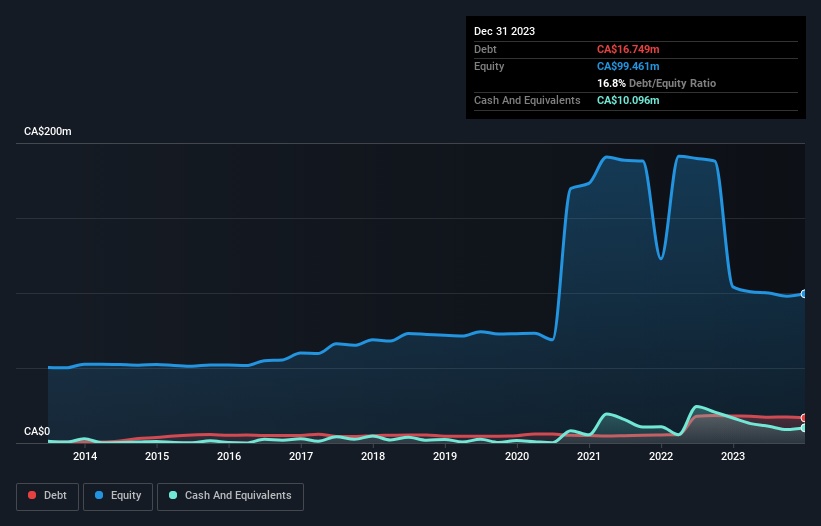Howard Marks put it nicely when he said that, rather than worrying about share price volatility, 'The possibility of permanent loss is the risk I worry about... and every practical investor I know worries about.' So it seems the smart money knows that debt - which is usually involved in bankruptcies - is a very important factor, when you assess how risky a company is. We note that Treasury Metals Inc. (TSE:TML) does have debt on its balance sheet. But should shareholders be worried about its use of debt?
When Is Debt Dangerous?
Debt is a tool to help businesses grow, but if a business is incapable of paying off its lenders, then it exists at their mercy. Ultimately, if the company can't fulfill its legal obligations to repay debt, shareholders could walk away with nothing. However, a more common (but still painful) scenario is that it has to raise new equity capital at a low price, thus permanently diluting shareholders. Having said that, the most common situation is where a company manages its debt reasonably well - and to its own advantage. The first thing to do when considering how much debt a business uses is to look at its cash and debt together.
Check out our latest analysis for Treasury Metals
What Is Treasury Metals's Debt?
The image below, which you can click on for greater detail, shows that Treasury Metals had debt of CA$16.7m at the end of December 2023, a reduction from CA$18.1m over a year. However, it does have CA$10.1m in cash offsetting this, leading to net debt of about CA$6.65m.

How Healthy Is Treasury Metals' Balance Sheet?
The latest balance sheet data shows that Treasury Metals had liabilities of CA$3.19m due within a year, and liabilities of CA$15.0m falling due after that. Offsetting this, it had CA$10.1m in cash and CA$329.2k in receivables that were due within 12 months. So its liabilities outweigh the sum of its cash and (near-term) receivables by CA$7.80m.
This deficit isn't so bad because Treasury Metals is worth CA$29.2m, and thus could probably raise enough capital to shore up its balance sheet, if the need arose. But we definitely want to keep our eyes open to indications that its debt is bringing too much risk. There's no doubt that we learn most about debt from the balance sheet. But it is Treasury Metals's earnings that will influence how the balance sheet holds up in the future. So when considering debt, it's definitely worth looking at the earnings trend. Click here for an interactive snapshot.
Given its lack of meaningful operating revenue, investors are probably hoping that Treasury Metals finds some valuable resources, before it runs out of money.
Caveat Emptor
Importantly, Treasury Metals had an earnings before interest and tax (EBIT) loss over the last year. Indeed, it lost a very considerable CA$12m at the EBIT level. When we look at that and recall the liabilities on its balance sheet, relative to cash, it seems unwise to us for the company to have any debt. So we think its balance sheet is a little strained, though not beyond repair. Another cause for caution is that is bled CA$11m in negative free cash flow over the last twelve months. So in short it's a really risky stock. When analysing debt levels, the balance sheet is the obvious place to start. But ultimately, every company can contain risks that exist outside of the balance sheet. Case in point: We've spotted 5 warning signs for Treasury Metals you should be aware of, and 3 of them make us uncomfortable.
If, after all that, you're more interested in a fast growing company with a rock-solid balance sheet, then check out our list of net cash growth stocks without delay.
Valuation is complex, but we're here to simplify it.
Discover if NeXGold Mining might be undervalued or overvalued with our detailed analysis, featuring fair value estimates, potential risks, dividends, insider trades, and its financial condition.
Access Free AnalysisHave feedback on this article? Concerned about the content? Get in touch with us directly. Alternatively, email editorial-team (at) simplywallst.com.
This article by Simply Wall St is general in nature. We provide commentary based on historical data and analyst forecasts only using an unbiased methodology and our articles are not intended to be financial advice. It does not constitute a recommendation to buy or sell any stock, and does not take account of your objectives, or your financial situation. We aim to bring you long-term focused analysis driven by fundamental data. Note that our analysis may not factor in the latest price-sensitive company announcements or qualitative material. Simply Wall St has no position in any stocks mentioned.
About TSXV:NEXG
NeXGold Mining
Operates as a gold exploration and development company in Canada.
Excellent balance sheet and fair value.
Market Insights
Community Narratives



